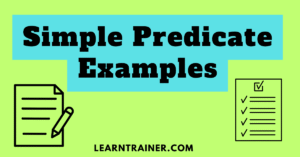Have you ever felt stuck in a conversation because you weren’t sure whether to use “on” or “in,” “at” or “by”? It’s a common struggle that many English learners, and even native speakers, face when it comes to prepositions.
These little words, though small in size, play a big role in communication. They connect elements of a sentence, helping us describe relationships between people, places, and things.
However, their correct use often leaves people scratching their heads.
In this article, we’ll take an in-depth look at 21 examples of prepositions, showing you how these words work and how you can use them effectively in everyday language.
Whether you’re trying to refine your writing, improve your speaking, or simply clear up any confusion, this guide is for you. Let’s dive in!
What Are Prepositions and Why Do They Matter?
Before we get into the examples, let’s start by understanding what prepositions are and why they’re so important.
Prepositions are words that show the relationship between a noun (or pronoun) and another word in the sentence. They help clarify where, when, how, and why something happens. Without prepositions, our sentences would often sound incomplete or confusing.
For example:
- She is in the room.
- He walked through the park.
- The keys are on the table.
In each of these sentences, the preposition connects the noun to another part of the sentence, explaining its position or the action taking place. Understanding prepositions will not only improve your grammar but will also help you make your communication clearer and more precise.
21 Examples of Prepositions
Here, we will explore 21 common prepositions with examples to illustrate their use in real-life contexts.
- In
- I am in the kitchen.
- The cat is sleeping in the box.
- On
- She placed the book on the shelf.
- He arrived on Tuesday.
- At
- I will meet you at the bus stop.
- The concert starts at 8 PM.
- By
- The letter was written by my friend.
- You can travel by car, train, or plane.
- For
- This gift is for you.
- I’m studying for my exam.
- With
- She is sitting with her friends.
- I came with my parents.
- Under
- The book is under the table.
- He hid under the blanket.
- Over
- There’s a picture over the fireplace.
- The plane flew over the mountains.
- Between
- The coffee shop is between the bookstore and the bank.
- Choose between the red and blue dress.
- Among
- She was sitting among her colleagues.
- He is among the top students in class.
- Through
- They walked through the tunnel.
- The river flows through the valley.
- After
- Let’s go for a walk after dinner.
- He arrived after the meeting ended.
- Before
- You should finish your homework before watching TV.
- I always drink coffee before work.
- Beside
- The chair is placed beside the desk.
- She stood beside her friend during the ceremony.
- Above
- The plane flew above the clouds.
- The painting hangs above the couch.
- Below
- The treasure was buried below the old tree.
- He lives below the top floor.
- Next to
- The bakery is next to the grocery store.
- He sat next to me in the theater.
- Behind
- The dog is hiding behind the curtain.
- The store is behind the park.
- In front of
- There is a car parked in front of the house.
- The teacher stood in front of the class.
- Against
- The wall is painted against a light shade of blue.
- He leaned against the railing.
- During
- I like to listen to music during my workouts.
- She studied during the entire weekend.
The Importance of Prepositions in Writing and Speaking
Now that we’ve covered 21 examples of prepositions, let’s talk about why these words are so crucial in both writing and speaking.
Prepositions can help you convey more specific information. For instance, imagine you’re telling someone the location of your house. Without a preposition, your description would be vague. “My house is street” doesn’t make sense. But by adding a preposition, like “on” or “near,” you can clarify your meaning: “My house is on Oak Street” or “My house is near the park.”
In writing, prepositions also help with sentence flow and coherence. They connect ideas, creating a logical progression that is easy for readers to follow. When speaking, prepositions provide context, ensuring your audience understands the specifics of what you’re describing.
Common Mistakes to Avoid When Using Prepositions
Even though prepositions are easy to define, they can be tricky to use correctly, especially for non-native speakers. Here are a few common mistakes to avoid:
- Mixing up similar prepositions:
It’s easy to confuse words like “in” and “on,” or “at” and “by.” For instance, saying “I am in the bus” instead of “on the bus” can sound awkward. Keep in mind the general rules: use “in” for enclosed spaces (like rooms, cities, countries) and “on” for surfaces (like a table, bus, or phone). - Using unnecessary prepositions:
Sometimes, we add prepositions that aren’t needed, such as “Where are you at?” or “I’ll call you back in a minute.” The word “at” is unnecessary in the first sentence, and the preposition “in” is not needed with “minute.” The correct forms are “Where are you?” and “I’ll call you back in a minute.” - Overusing prepositions:
It’s tempting to throw in multiple prepositions, but doing so can make your writing wordy or unclear. For example, instead of saying “I am sitting on the chair in front of the table,” you could simplify the sentence: “I am sitting in front of the table.”
A Quick Table for Easy Reference
Below is a quick reference table that shows the prepositions discussed in this post and provides a short explanation for each. This table is meant to help you remember their key uses and meanings.
| Preposition | Example | Explanation |
| In | I am in the car. | Used for enclosed spaces or periods of time. |
| On | The book is on the table. | Used for surfaces or specific days. |
| At | I will meet you at the station. | Used for exact locations or times. |
| By | The letter is by the door. | Indicates proximity or means of transportation. |
| For | This is for you. | Used to indicate purpose or duration. |
| With | She is with me. | Shows companionship or means of doing something. |
| Under | The cat is under the bed. | Describes position beneath something. |
| Over | The lamp is over the table. | Indicates position above something. |
| Between | The ball is between the shoes. | Shows a position between two items. |
| Among | The secret is among us. | Indicates being part of a group. |
Conclusion
Prepositions may seem small and simple, but they are essential in expressing relationships and directions within a sentence.
By mastering them, you can improve your language skills, whether you’re writing an essay, having a conversation, or giving a presentation.
Remember, the key is practice—use these prepositions in your daily conversations and pay attention to how they are used in the world around you.
Do you have any favorite prepositions or tricky ones that always confuse you? Drop a comment below! Or, if you found this post helpful, feel free to share it with a friend who might need a little help with their prepositions too.
FAQs
- What is the difference between “at” and “on”?
- “At” refers to a specific point or location (e.g., “I will meet you at the station”), while “on” refers to a surface or a more specific point in time (e.g., “The book is on the table”).
- Why are prepositions so difficult to learn?
- Prepositions don’t always translate well between languages, and their usage can seem arbitrary. However, with practice and exposure to different examples, you’ll get a better feel for them.
- Can prepositions change based on the context?
- Yes! For example, “on” can refer to a surface (“on the table”) or a day (“on Monday”). Context helps determine which preposition to use.
- How can I practice using prepositions correctly?
- The best way to practice is by reading and listening to natural English. Pay attention to how prepositions are used in books, movies, and conversations. Try writing sentences or short stories using different prepositions.
- Are there any prepositions that are often confused?
- Yes! “In” vs. “on,” “at” vs. “by,” and “between” vs. “among” are common areas where learners make mistakes. It’s important to learn the specific contexts where each preposition fits best.

